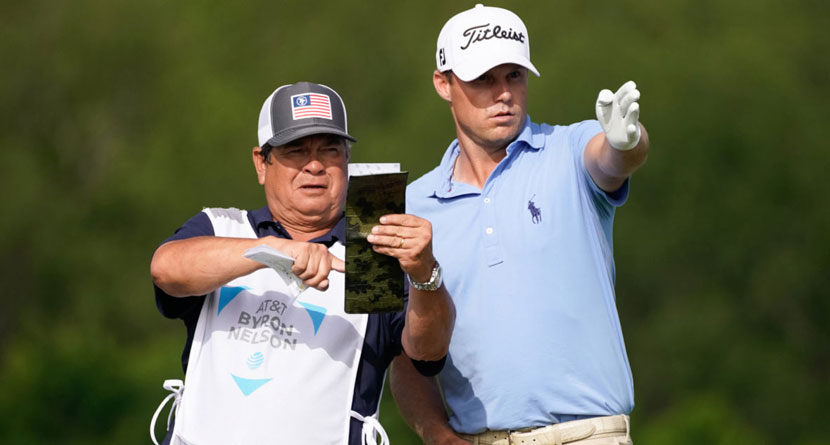By CRAIG DOLCH
It started for Tony Navarro with a Greyhound bus ride in 1978. Fresh out of high school, Navarro left his hometown of Moline, Ill., to make the trek to Glen Abbey Golf Club, hoping to caddie at the Canadian Open.
His pockets filled with only $200, the bus ride cost Navarro $50. It would take the 18-year-old two days of carrying a bag to make that initial investment back. If he found a player.
Finding a place to sleep? Good luck with that on 25 bucks a day.
“I just wanted to do it for the summer,” Navarro said. “When you’re young and single, you can sleep anywhere. I remember sleeping in gas-station bathrooms – where you would lock the door and feel safe – or in cars and orange groves.”
Not real glamorous, huh? But that’s how it worked on the PGA Tour in the late-1970s, where only 60 players were exempt and less than that could make a living toting a bag.
“It was a good time to keep your mouth shut, your eyes open and learn a lot,” Navarro said. “I started making some good friends.”
Four decades later, Navarro can look back on his career as a magic carpet ride. He eventually got to caddie for some of the legends of the game – Raymond Floyd and Greg Norman, to be specific – while also walking fairways with major champions such as Adam Scott, Seve Ballesteros, Angel Cabrera, Ben Crenshaw, Hal Sutton, Gary Woodland and Jeff Sluman.
Navarro even had a chance to caddie for Tiger Woods when he dropped Mike “Fluff” Cowan in 1999, according to the game’s top instructor, Butch Harmon.
“I told Tiger there were two guys he should hire – Tony Navarro and Steve Williams,” Harmon, who was Tiger’s instructor at the time, said Sunday. “I spoke with Tony first. But he said, ‘No, I’m still working for Greg.’
“That’s the kind of guy Tony is. He’s incredibly loyal. Whoever he works for, he’s 100 percent invested in that person.”
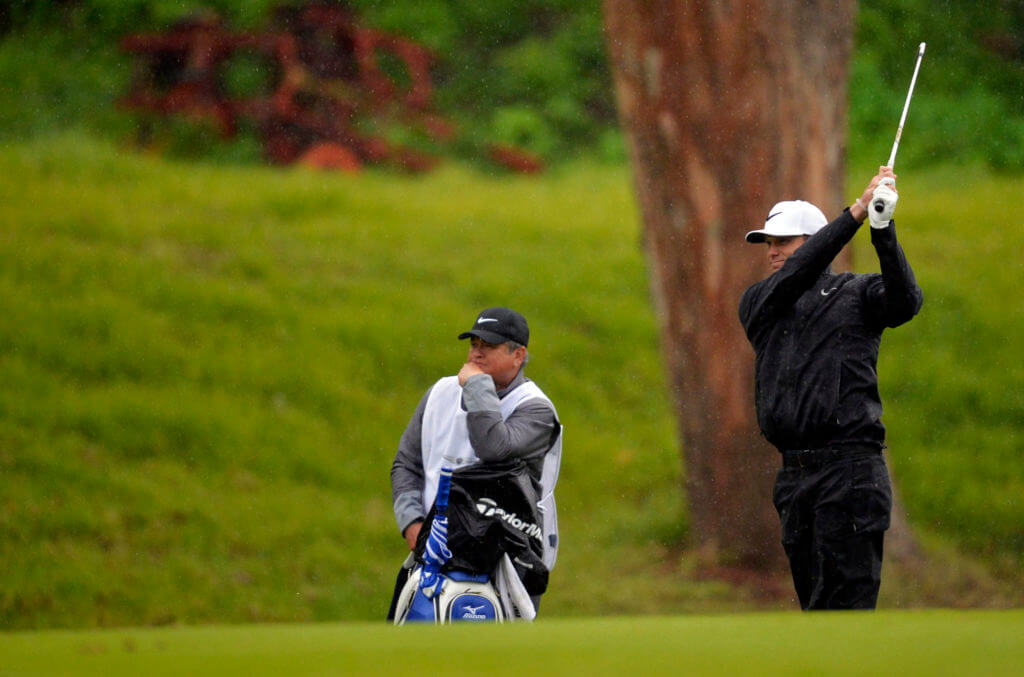
Navarro eventually went from sleeping in bathrooms and cars to staying in five-star resorts and castles, while traveling first class in private jets. Navarro knows how lucky he’s been to have worked for players who have won almost 50 tournaments around the world, including a major (by Norman).
There are no exact records, but it’s doubtful any caddie won more PGA Tour events with as many different players, or worked with as many players who either won or would win major championships.
“That says a lot about Tony’s demeanor and how hard he works,” Harmon said. “All these guys came to him. Caddies don’t solicit guys. The player picks the caddie. These guys all wanted Tony to work for them.”
Did Navarro get lucky? Of course, but isn’t it often the case the best at their business seem to get a few breaks along the way?
“I consider myself a fortunate person,” Navarro said. “Caddying takes a little time, but once things start going your way, it’s well worth it.”
**************************************
The first time Navarro caddied for a pro was at his hometown Quad Cities Open. Navarro landed his first “name” pro when he made a handshake deal with Slugger White, who went by Carlton White back then.
Slugger played the tour from 1976-79, winning once, before he switched to becoming a rules official. Today, Slugger is the PGA Tour’s vice president of rules and competition.
“Slugger treated me so well, but I made no money caddying for him,” Navarro said. “To this day, we can’t look at each other on the course without giggling. He tells me I owe him so much for all the good players I got after him. I tell him I caddied just bad enough for him to get a cart job.”
Navarro’s first big break came when he got Floyd’s bag. Floyd was a no-nonsense pro known for his stare when he got into contention. There were few mulligans when you caddied for Floyd.
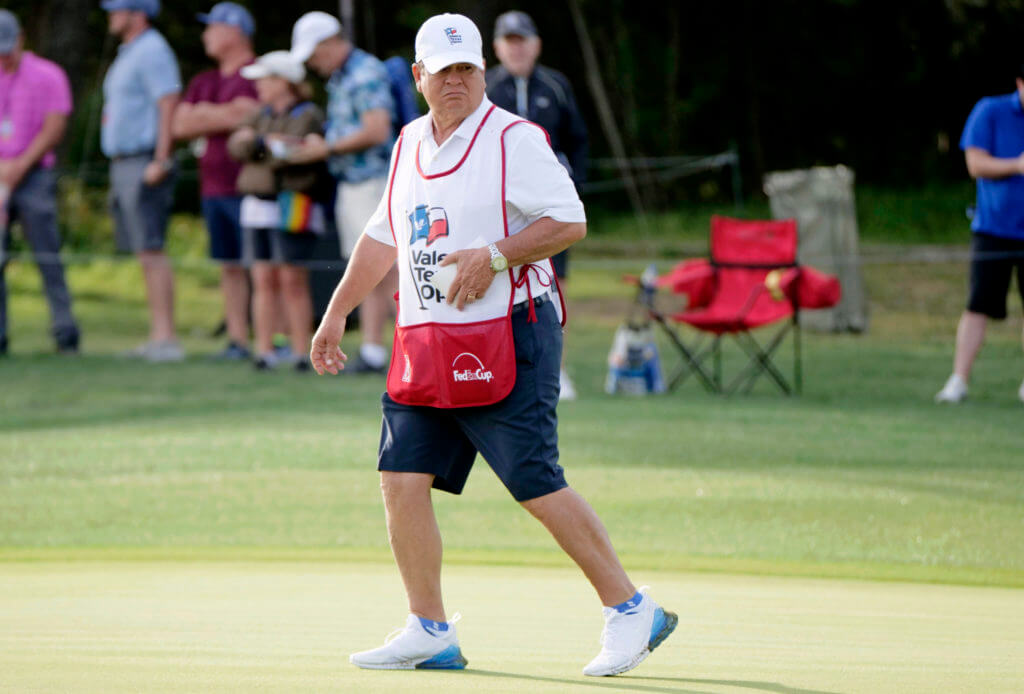
Navarro said he learned a lot from working with Floyd. Also, he saw a different side of the Hall of Famer.
“Raymond took me under his wing and treated me like family,” Navarro said. “He took me to my first-ever dentist appointment when I was 21 or 22. His kids were so little and they would fight to see who would get to sit next to me at the dinner table.”
“Tony was like a son to me,” Floyd said Friday from his home in Delaware. “We had a special relationship that went a little farther than most caddies. He was always willing to learn and that was great.
“When I told him the way I liked things done, he never got it wrong. If he doesn’t do what I’m expecting him to do, that throws off my game. There has to be a kind of simpatico.”
Even with a pro as stern as Floyd, Navarro was willing to speak up when needed. Not many caddies had the guts.
“Tony wasn’t afraid to say something like ‘Hey, pro, you’re getting pretty negative here,’” Floyd said. “You have to have that kind of relationship.”
The pair even exchanged pranks during their time together. Floyd was proudly known as the Hand Grenade for his penchant for dropping dry jokes that took a few seconds for some to realize. During a practice round at Muirfield Village, Floyd had hit his approach shot into the par-5 11th hole where a creek runs to the left of the fairway. Navarro knew Floyd was scared of snakes.
While Floyd was walking next to the creek, Navarro took the iron his player had just hit and, from behind, inserted it up the side of one of Floyd’s pants legs.
“I almost had a heart attack,” Floyd said, before following with a belly laugh at the memory. “I literally jumped. I just told him, ‘I’ll get you back.’ And eventually I did.”
Says Navarro: “Every time I walk over that bridge at No. 11, I think of Raymond.”
Navarro moved on to another Hall of Famer, Ben Crenshaw. Gentle Ben was coming off a thyroid condition that severely affected his career in the mid-1980s.
They spent three years together and won four times. While Crenshaw didn’t need much help with his game – “He was hard to read greens for because he played so much break; he had such a great eye,” Navarro said – the caddie learned more lessons from this partnership.
Then again, Navarro said he learned from every player he worked for.
“Ben was a gentleman,” Navarro said. “He treated everyone well, always knew them (caddies) by their first name. He liked hanging with the caddies in our tent more than he did in the locker room. That’s the kind of guy Ben was.”
Next up for Navarro was a pair of former major champions, Hal Sutton and Jeff Sluman. Those stints didn’t last long.
Navarro thought he would be with Sluman for a while until Harmon approached Navarro in 1992 and said Norman wanted him to caddie for him. Navarro initially declined, saying he already had a job.
Sluman soon fired Navarro. “Jeff said I was a fool if I didn’t take the job with Greg,” Navarro said.
Landing the Great White Shark was a career changer – and life changer — for Navarro. He was working for the world’s top player (Norman had been No. 1 in the world rankings for a combined 128 weeks by then), in his prime (37), who had his own private jet and a flair for doing everything first class.
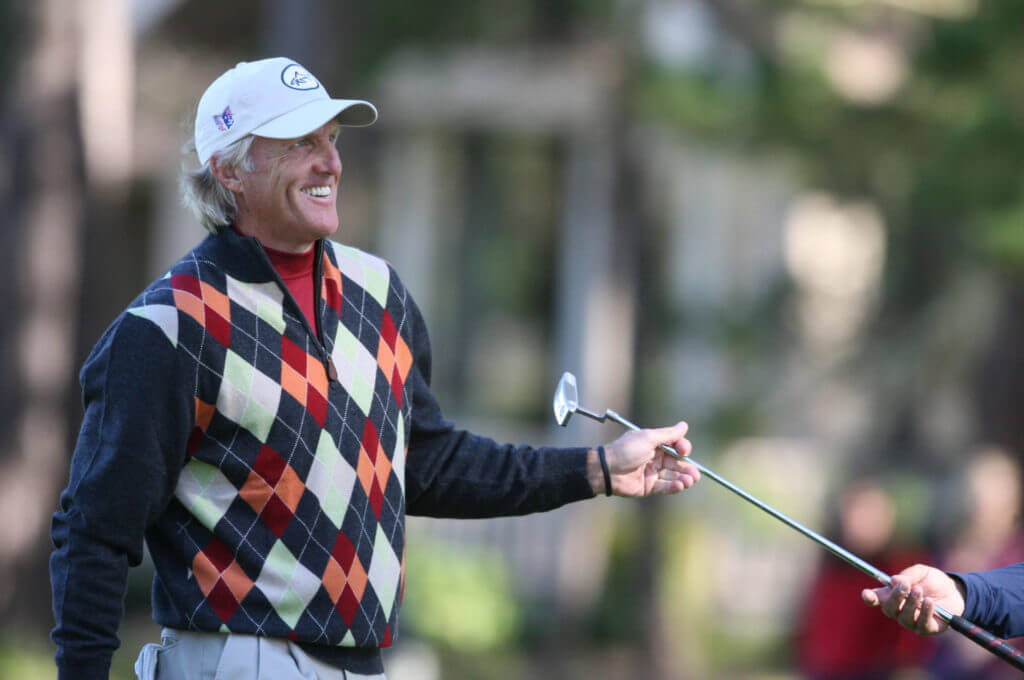
But like working for Floyd, caddying for Norman was not always a walk in the park. It took years of experience and days of biting your tongue.
“Greg was very intense, very hard working. A perfectionist,” Navarro said. “He was hard to be around sometimes on the golf course, but great to be around off the golf course.
“Greg treated me so damn good. He treated me and my family like they were his family. He would let me take my wife with us and we stayed where Greg stayed. If Greg stayed at a Ritz-Carlton, we stayed at a Ritz-Carlton. If Greg stayed at a castle in Ireland, we stayed at the castle in Ireland.”
Norman knew he wasn’t an easy boss. His intensity and desire to win burned so bright, there were inevitable battles on the course.
“I never saw one bill. Greg took care of everything. We were just trying to keep her alive. Greg really stood up and showed me what he was made of.” — Tony Navarro on Greg Norman’s generosity as the caddie’s newborn daughter fought for her life
When asked last week what made Navarro such a good caddie, Norman said, “His professionalism and loyalty. He understood the game as much as he understood me, the player. But he also knew me the person — my idiosyncrasies, mannerisms, expectations from myself, my mood — and he served as a confidant. A great caddie knows when and how to step in and when not to.
“A player spends more time with his caddie than his wife/significant other, so friendship, compatibility and respect for each other’s space is at times critical to how the interactions work on the course. Tony is still one of my dearest friends.”
It didn’t take long for the partnership to click. Norman had won just one major, the 1986 British Open, but was known more for having eight runner-up finishes in majors and many more near-misses.
In their third major together, the 1993 British Open at Royal St. George’s, Navarro knew his player had a great chance at winning another claret jug.
Then Norman steps to the first tee, hits his drive down the middle and watched the ball carom to the right into a bush. They never found it.
“We start the week by losing a ball on a hole with no OB,” Navarro said. “You’re thinking, ‘It’s going to be a long week.’”
It proved to be – for the rest of the field. Norman rallied from the opening double bogey to shoot 66 and share the first-round lead with Mark Calcavecchia and Fuzzy Zoeller – two players who had previously denied Norman majors – and Peter Senior.
Norman followed with rounds of 68 and 69, leaving him a shot behind Nick Faldo and Corey Pavin entering Sunday. Norman relied on instructor Harmon’s advice to throttle his clubhead speed back, and Norman put on a driving clinic that afternoon.
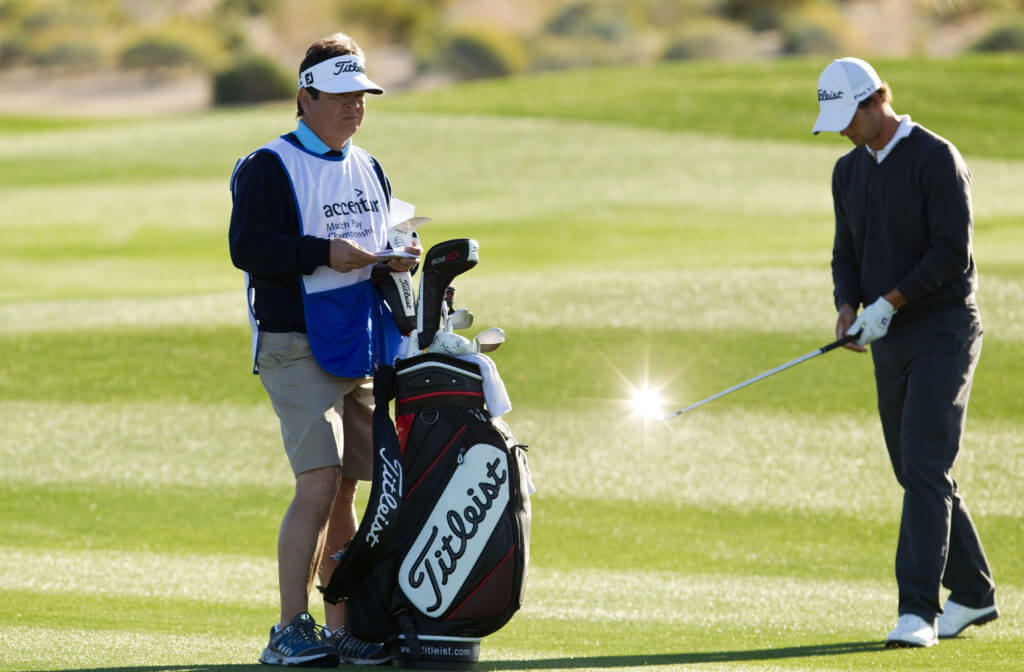
Afterward, Norman said he hit “every shot perfect” during his 6-under 64. Navarro admits he was only worried one time, on the par-5 14th, when playing partner Bernhard Langer had hit his tee ball out of bounds just right of the fairway.
“I’m thinking we got the whole world left, but Greg pumped his drive right down the middle, 15 yards from the OB,” Navarro said. “I knew we had it from there.”
Norman finished two shots ahead of Faldo to finally claim his second major. As was his penchant, Navarro, who earned his first 18th-hole flag at a major, stayed in the background while Norman soaked in the adoration.
“I remember Greg being so happy, and me being happy for him,” Navarro said. “I know we had a nice flight back to the U.S. with Maria and Raymond Floyd with us. We emptied the liquor cabinet.”
The Norman-Navarro partnership won more than 20 tournaments during their 12 years together while Greg spent almost 150 more weeks as world No. 1.
What Navarro liked about the relationship was he was encouraged to disagree with his boss. Norman didn’t want a “yes man” on his bag, and that’s the way it should be.
When asked if he had a favorite moment with Navarro on the course, Norman smiled.
“I used to love when he would just say ‘Mmmmmmm,’ knowing the shot I just hit was on the money by sound and flight before it even landed,” Norman said. “It was so cool to hear him do this, as he knew.”
There’s one other story that needs to be told here. Navarro’s wife, Sarah, had given birth to their second daughter, Megan, in early 2000. Navarro had to soon get on a plane because Norman was playing in a tournament in Perth, Australia.
A day after they got to Perth, Sarah called Norman. “I think you need to send Tony home,” she told Norman. “Megan is in the hospital and the doctors don’t know if she’s going to make it.”
Norman immediately put Navarro on a flight to Moline – first class – and Megan spent a month in a Peoria hospital before doctors discovered she had botulism, a rare poisoning.
“Greg called every single day, sometimes twice a day,” said Navarro, who was overcome by emotion when telling this story last week.
Like most caddies, Navarro had no insurance. But that didn’t matter.
“I never saw one bill. Greg took care of everything,” Navarro said. “We were just trying to keep her alive. Greg really stood up and showed me what he was made of.”
Megan fully recovered and is a healthy 19-year-old. Tony’s relationship with Norman was never the same – only better.
Even after Navarro moved on in 2004 to start working with one of Norman’s proteges — Adam Scott (at Norman’s urging) — their friendship remains strong. That’s usually not the case when most players and caddies sop working together.
To this day, when Navarro works at the Honda Classic at PGA National, he will stay with Norman at his nearby Jupiter Island mansion.
“I love the man,” Norman said. “He is a class act and there is absolutely no reason why we should not be great friends. We achieved so much. Watched our families grow and our lives evolve. He will always have an open door at any place of mine.”
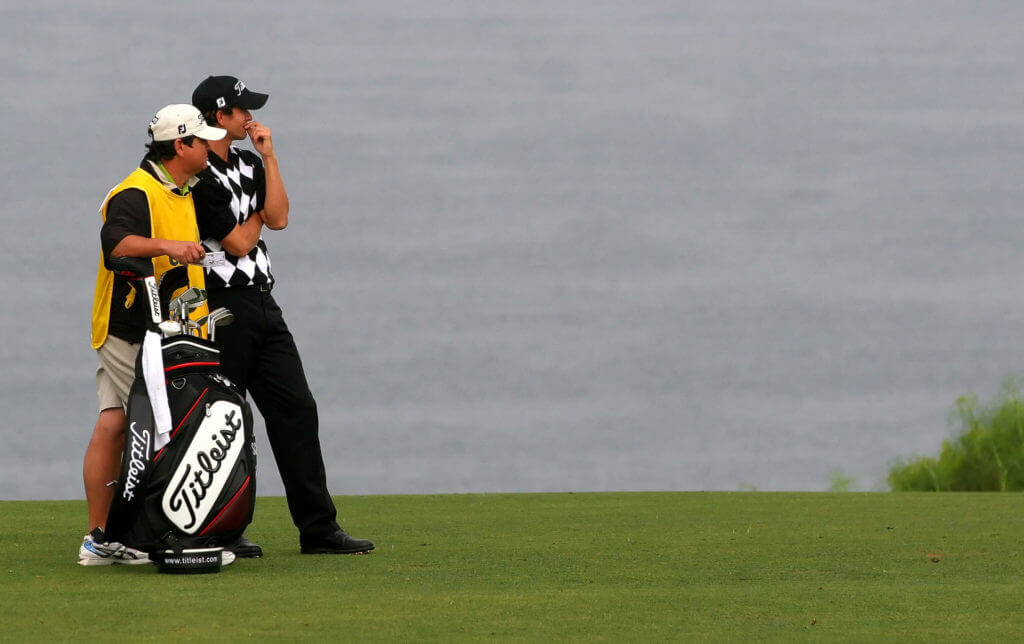
Navarro worked with Scott from 2004-11. They won more than 10 tournaments together.
“Adam was great to work for. A gentleman and a helluva player,” Navarro said. “He’s very underrated, a lot better player than probably his career has showed. He’s going to be a good player for, who knows, eight to 10 more years. He understands the game well and he putts pretty good when he needs to.”
After Scott let Navarro go, not long after they finished second at the Masters, Navarro looped for Bud Cauley for a short time before landing another player with Harmon connections: Gary Woodland.
Woodland was a great ball striker, but struggled to win tournaments because of a so-so short game. When Navarro saw Woodland playing so quickly and confidently on and near Pebble Beach’s greens during this year’s U.S. Open, he knew his former boss had a great chance to win.
“I was so proud of him,” Navarro said of Woodland. “I won’t admit it to him, but we’re still good friends. We still exchange texts and calls almost every day.”
The only downside to working with a bunch of great players is, inevitably, you stop working for them. Navarro said he never took the firings personal.
“I’m very close with everybody I caddied for,” Navarro said. “It takes a few months to get over it (firing), but we’re all in this together. If you carry a chip on your shoulder, it’s only going to weigh you down.”
Navarro’s current boss is Nick Watney. They have worked together for three years.
“He’s a legend,” Watney said. “Nobody has seen it all, but he’s close to it.”
A few years ago, Golf Digest included Navarro in their rankings as the top-36 caddies of all time (in no order). Navarro didn’t run out and buy a bunch of copies of the magazine.
“It really didn’t mean that much to me,” he said. “I don’t think I’m better or worse than anybody. I could name 36 guys they left out who are really great caddies.”
Navarro doesn’t have any of his 18th hole flags on display at his home. That’s not his style. He couldn’t even tell you how many tournaments his players have won over the years, because he never kept count.
“I didn’t accomplish it; the players did,” Navarro said. “I’ve been lucky to be around these guys. That’s what I remember most is the friendships.”
Navarro will turn 60 in December, but he sees no end in sight. He’s healthy and, even though he won’t say it, he’d never be unemployed for long.
“I’d like to do this at least another four or five years,” he said. “Being a caddie is a big part of my life.”
More than 40 years later, the joy ride continues for Tony Navarro.
T.J. Auclair is the Director of Content for The Caddie Network and has covered professional golf since 1998, traveling to over 70 major championships.
